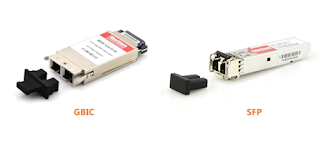Life is full of choices. When it comes to transceivers, there
are also a wide range of modules that you can choose from, such as GBIC, SFP, SFP+, QSFP, CFP
and other modules. While, when referring to Gigabit interface module, SFP module will usually
come into our mind firstly. As a matter of fact, we have automatically neglected another
Gigabit interface module: GBIC. So why would GBIC be gradually replaced by SFP? What are their
common points and differences? The answers will be discussed in more detail at a later
stage.
The Conception of GBIC and SFP/Mini GBIC
GBIC stands for Giga Bitrate Interface Converter which was
quite popular in 1990s. The design can be used for hot plug with SC interface. The devices are
economical since they help make the unnecessity for replacing entire boards at the system
level a reality. By offering a standard and hot swappable electrical interface, one gigabit
port can support a diverse range of physical media from copper to long-wave single-mode
optical fiber.
SFP/Mini GBIC means Small Form-Factor Pluggable which can be easily
regarded as an upgraded version of GBIC. SFP transceivers are designed to support SONET,
Gigabit Ethernet, Fibre Channel and other communications standards. SFP module with LC
interface is much smaller than GBIC module. Due to their similarities and its smaller size,
SFP is also called “mini-GBIC”.
GBIC vs. SFP: What Are Their Differences?
These small, modular optical interface transceivers offer a
convenient and cost effective solution for the adoption of Gigabit Ethernet and Fibre Channel
in data center, campus, metropolitan area and storage area networks. Both of them are doing
more or less the same things, and GBIC and SFP are equal in performance, so what are their
differences?
1.The size of GBIC is larger, the volume of it is the double of SFP module or mini GBIC.2.GBIC uses the SC interface, while SFP employs LC interface.
3.GBIC module corresponding switch is GBIC slot, but SFP module corresponding switch is SFP slot.
GBIC vs. SFP: How to Choose Them?
If you do not have a switch or line card when choosing a GBIC
or SFP/mini GBIC, it will usually depend on the number of interfaces required and availability
of the switches and lines cards’ specific model. For instance, if you want two interfaces on
a line card in 6500 switch, you need to use an 8 port GBIC line card which is available. In a
similar way, If you need 24 fiber interfaces, you’ll use a 24/48 port SFP line card.
Conclusion
The superiority in size of SFP/mini GBIC is very attractive
for many people, especially for those who have large demand, because it will save space. But
it is precisely because of this single difference, SFP rapidly gained popularity with people
who want to maximize their space. With SFP becoming more popular, GBIC was also out of favor.
However, you can still decide to use GBIC port or SFP port according to your own situation and
demands. Fiberstore provides all kinds of SFP modules, such as 1000BASE-T SFP, 1000BASE SX
SFP, 1000BASE LX SFP and etc. If you would like to buy GBIC modules, Fiberstore is also a good
choice.

评论
发表评论